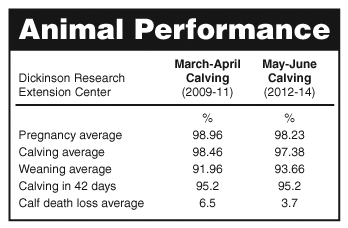
Kris Ringwall
Beef Talk
Shifting calving from March to May didn’t change the
cow herd’s reproductive performance.
Dickinson Research Extension Center data show the pregnancy percentage for cows exposed for March-born calves was 98.96% and for cows exposed for May-born calves was 98.23%. Interesting!
The center has been calving in May since the 2012 calf crop. Prior to 2012, the center herd calved in March. Overall management change within a beef cow-calf operation is not easy, and the ripple effect is real.
The center reviews managerial changes regularly to provide effective management for the beef operation. A review of the change in calving season seems natural because the center will be calving for the fourth year in May this spring.
One common question is, “How well will cows breed in late summer?” Because of late-summer heat inhibiting cattle reproduction, this is certainly a legitimate concern if, in fact, true.

So, to explore that question and other responses to breeding in August, a process to review the two calving seasons was initiated. The performance of the center’s herd for the years 2009, 2010 and 2011, when the center was calving in March/April, as well as the years 2012, 2013 and 2014, when the center was calving in May/June, was reviewed. Care needs to be noted because labor, land and facilities do not allow a concurrent, actual study, so a review of the managerial records is the next best option.
Managerial reviews do not imply a cause and effect; rather, they offer observations and thoughts that lead to future efforts. The center is involved in the Cow Herd Appraisal Performance System (CHAPS) program, made available by the North Dakota State University (NDSU) Extension Service in cooperation with the North Dakota Beef Cattle Improvement Association (NDBCIA). The evaluation of the two calving seasons was done using the center’s CHAPS data.
For the 2009, 2010 and 2011 March/April calving season, the center turned bulls out June 1 or thereabouts. The average date that the third mature cow calved during those years was March 15, with the average calving date being March 29.
Rebreeding statistics were excellent:
| • average pregnancy percentage | 99% |
| • percentage of cows calving | 98% |
| • percentage of cows weaning a calf | 92% |
| • percentage of cows calving in 42 days | 92.5% |
| • calf death loss percentage | 6.5% |
| • cows’ average age | 4.8 years |
| • average cow weight | 1,307 pounds (lb.) |
| • average cow condition score | 5.6 |
Overall, herd reproduction at the center was greater than the CHAPS benchmark values. The current CHAPS benchmarks for pregnancy are 93.1% (center, 99%), calving 92.5%, (center, 98%) and weaning 89.8% (center, 92%). The benchmarks for cows calving in 42 days is 86.4% (center, 92.5%) and calf death loss is 3.4% (center, 6.5%).
March calving was working for the center, so why change the calving date? Even when a production system is working, change should be part of any planning discussions. Granted, in years like this, calving in March looks like a no-brainer. The weather is great. Why not simply enjoy it?
However, three major areas of concern still remain. They are labor shortages, potentially adverse weather and increasing costs. Successful calving requires dedicated people with the needed skill set to calve cows. Warmer weather makes the task of calving easier. The expense bucket is full, and the pending fear of fiscal failure is real.
Primarily due to the shortage of labor, recent adverse weather and the ever-increasing costs, the center changed and delayed the turnout of the bulls to Aug. 1 or thereabouts for 2012, 2013 and 2014. The average date that the third mature cow calved during those years was May 7, with the average calving date being May 25.
Rebreeding of the May- and June-calved cows has been excellent, with the following stats:
| • average pregnancy percentage | 98% |
| • percentage of cows calving | 97% |
| • percentage of cows weaning a calf | 94% |
| • percentage of cows calving in 42 days | 5.2% |
| • average calf death loss percentage | 3.7% |
| • cows’ average age | 5 years |
| • average cow weight | 1,437 lb. |
| • average cow condition score | 5.3 |
The reproductive performance of the cows on pasture when the center was calving in March/April was very similar to the performance of cows on pasture when calving in May/June. Shifting the calving date to May did not significantly change the reproductive performance of the cow herd.
The question of negative effects on rebreeding cows in August was not evident in a review of the center’s management. However, calf death loss was much improved.
May you find all your ear tags.

Editor’s Note: Kris Ringwall is a beef specialist for North Dakota State University Extension. For more information, contact www.ag.ndsu.edu/news or North Dakota State University Extension Service, NDSU Dept. 7000, 315 Morrill Hall, P.O. Box 6050, Fargo, ND 58108-6050.
[Click here to go to the top of the page.]






